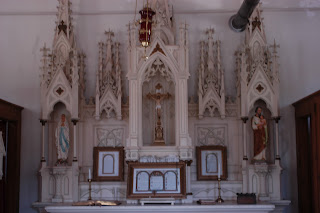We finally made it to Red Cloud. We arrived here on Sunday morning, so it was largely a ghost town. The Willa Cather Society had a walking tour map in front of the Opera House, so we picked one up and looked around. Nebraska seems harder hit by the drought than many of the other places we have been, and the whole place seems hot, dry and sad. It is easy to imagine Cather's despair at having been brought here from lush Virginia.
After lunch, we decided to go on a guided tour. I did not know if we would see much that we didn't see our self-guided tour, but wanted to hear what they said. The Willa Cather Foundation owns many of the properties related to Cather and runs the tour. The Cather Foundation has worked hard to identify the sources of the people in her books. They want to portray her as a local author, even though she seldom visited after she left for college at 16. They have done what seems like a thorough job of identifying people, and it is interesting to see sights important to them. Our guide was also aware of certain problems; there was a person here named Jim Burden, but the character Jim Burden was based more on Cather herself than on him (although some details of his family life seem to be from the historical Jim Burden).
The Willa Cather Society is aware of the tension between portraying Cather as a local writer who wrote about people she knew, and Cather as a writer of fiction that transcends mere recollection. There is a short film that accompanies the tour that makes it clear that Cather's writing itself should be what we remember most. I wish I had a transcript for the film so I could quote it directly.
This is the only area that has set out to preserve the memory of Willa Cather in earnest, and there are considerably fewer people coming here than to any of the Laura Ingalls Wilder sites. Our tour had thirteen people, and our guide said it was the largest she has ever had. The guide wanted us to see the places that were mentioned in the books, and she knew which books corresponded with particular rooms. She did not reflect on the extent to which Cather was a sentimental writer, nor whether preserving these sites might affect the way the books are interpreted.
This is the church that Annie Sedilek, the model for Antonia, had her son baptized and was later married. They could not afford a bell or a priest, so they would blow a whistle when a circuit priest was on his way.
Annie Sedilek
This is the place where Annie Sedilek would have slept when she was working for the Miners, who provided the model for the Harlings in My Antonia. The local lore says Mr. Miner really was gruff and brought an end to the fun at this house whenever he was in town, just like Mr. Harling.
This is how the Sedilek homestead looked when it was purchased by the Willa Cather Foundation.
This is the site of a "suicide grave" that Willa Cather found moving.


































